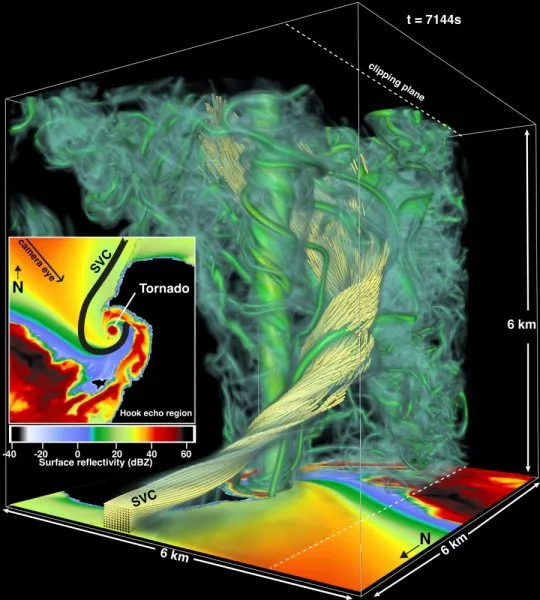Check Out the Most Detailed Tornado Simulation So Far
A supercomputer created a simulation of the F5 “El Reno” tornado which devastated part of Oklahoma in 2011
In the climax of the classic 1996 disaster movie Twister, scientists are able to map a tornado by deploying a bunch of sensors into a storm, but not before nearly being sucked up by an F5 tornado. Now, researchers have created a similar simulation of the internal workings of tornado, without Hollywood magic or at risk of life and limb. According to a press release, researchers using a supercomputer have created the most detailed simulations of the inner workings of tornados so far.
George Dvorsky at Gizmodo reports that the team led by University of Wisconsin-Madison atmospheric scientist Leigh Orf, created a model of the category 5 "El Reno" tornado that cut a 63-mile swath through Oklahoma in May 24, 2011, staying on the ground for two hours and killing nine people. Using the Blue Waters Supercomputer at the University of Illinois at Urbana-Champaign, Orf and his team loaded observed data into the machine, including temperature, wind speed, air pressure, moisture, wind shear and other factors. The simulation shows how these conditions combined to create a super cell, which eventually spawned El Reno, a process called “tornadogenesis” or the creation of a twister.
Even if conditions are ripe for a tornado, that doesn’t necessarily mean one is going to form. Why some supercell storms spawn tornadoes and others don’t is the type of question the researchers are hoping the new detailed simulation will help answer. “In nature, it’s not uncommon for storms to have what we understand to be all the right ingredients for tornadogenesis and then nothing happens,” Orf says in the press release. “Storm chasers who track tornadoes are familiar with nature's unpredictability, and our models have shown to behave similarly.”
According to the press release, it took around three days of processing for the supercomputer to model El Reno, something that would have taken a typical desktop computer decades to produce. According to Chris Higgins at KTVI in St. Louis, the new simulation has a resolution of 30 meters, versus a resolution of 1 kilometer in previous models. “Everyone who sees these simulations pretty much their jaw drops…because it looks so realistic,” Catherine Finley, assistant professor of meteorology at St. Louis University who worked on the project tells Higgins. “We are seeing things in the simulation that we have not seen in previous simulations and that they are just starting to see in some Doppler radar observations out in the field.”
For instance, the simulation shows that the El Reno system created several mini-tornadoes as the main twister formed. Those smaller twisters merged, adding power to El Reno and increasing its wind speeds. Over time another structure formed, dubbed the "streamwise vorticity current." A feature of many strong tornadoes, the SVC is a column of air cooled by the rain that is sucked in by the tornado’s updraft, adding more power to the storm.
According to the press release, however, there is still a place for storm-chasers and more adventurous scientists in the digital age. The simulations are dependent on high-quality atmospheric observations collected just before tornadoes form. Orf says that with more observations and more computing power, he hopes to create even better models. “We've completed the EF-5 simulation, but we don't plan to stop there,” he says. “We are going to keep refining the model and continue to analyze the results to better understand these dangerous and powerful systems.”
And the need for understanding tornados seems to be growing. In the U.S. more than 1,000 twisters touch down per year on average. As climate change continues, tornados are also increasing, with one study showing that over the last 50 years, while the number of severe storms that cause multiple tornadoes outbreaks has remained steady at about 20, the number of tornadoes that occur in those outbreaks has increased from roughly 10 in 1950 to about 15 today.


